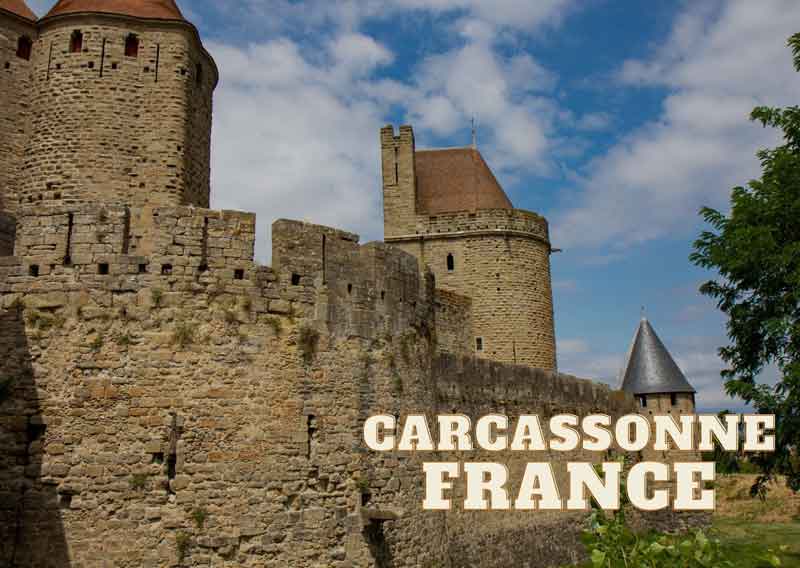So, is Carcassonne worth visiting? If you are visiting the Occitanie Region of France, it is definitely worth spending a few hours exploring this UNESCO World Heritage Site. La cité médiévale of Carcassonne has an impressive 52 turrets, 3km of ramparts and is free to visit!
We live 40 minutes away from Carcassonne and have visited La Cité Médiévale on more than one occasion. Carcassonne is a place of historical interest and is a magical setting to explore whatever your age and whatever the season. This article has been written to give you an idea of why Carcassonne is worth visiting and some of the things you can see and do.
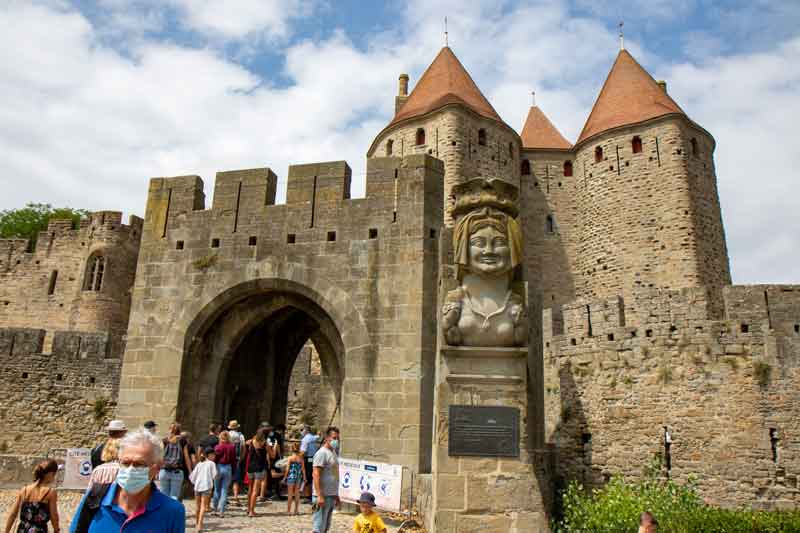
Is Carcassonne Worth Visiting?
In addition to being a UNESCO World Heritage Site, here are our top reasons why Carcassonne is worth visiting:
1. Historical Interest – Carcassonne is the Largest Surviving Medieval Fortress in Europe!
The medieval fortified citadel of Carcassonne, which is also known as the Cité de Carcassonne, offers visitors the chance to appreciate a carefully restored example of a concentric castle. Although the castle was repaired and rebuilt in the 1800s, it is one of the largest surviving medieval fortresses in Europe. Undeniably, it is a magnificent sight to behold.
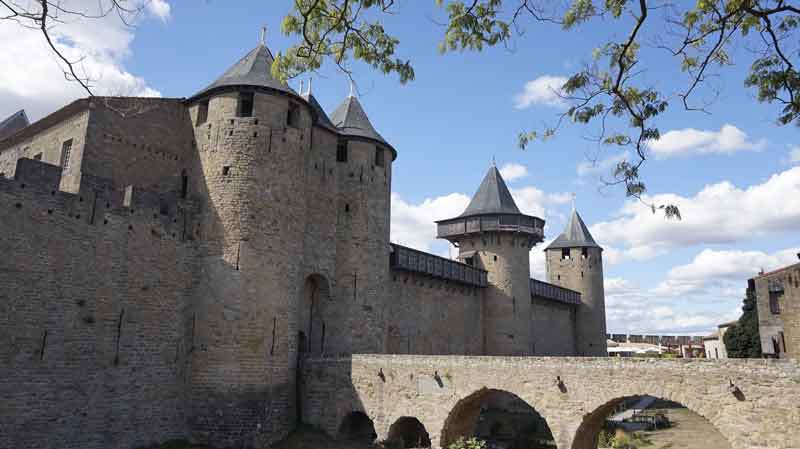
Two enormous outer sandstone walls surround the Old City which are approximately 3km long. The outer curtain wall was built in the 13th Century and has a circumference of 1,600m. Standing at the base of the impressively 10-12m high walls, makes you realise why this castle resisted many attacks throughout its history.
Despite having been restored and completely recreated from the mid 1800s onwards, Carcassonne won’t fail to disappoint as it has a completely authentic medieval feel. Where else will you get the chance to experience such a perfect example of a medieval citadel? It’s much better than visiting crumbling ruins!
2. Fairy-tale Setting with Stunning Views – Carcassonne Transports You Back in Time!
Stepping over the drawbridge, under the portcullis and through the imposing City Gates (La Porte Narbonnaise) into the narrow, winding streets of Carcassonne is like stepping back in time and is quite magical. It’s difficult to decide where to look or point your camera first! Quaint medieval stone and timber buildings line the cobble stone streets with plenty of small passages and squares waiting to be discovered.
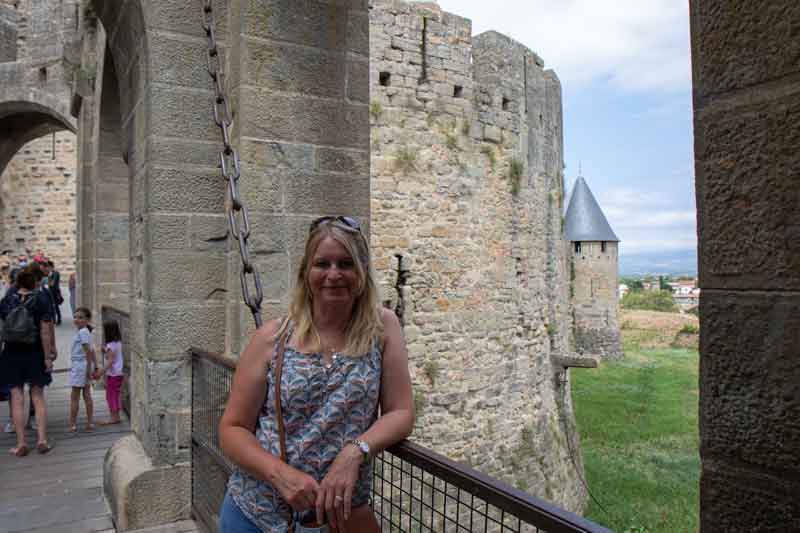
The skyline is dominated by Carcassonne’s 52 round and square towers which are strung together by its enormous outer walls and ramparts. From the ramparts, there are stunning views over the surrounding area thanks to the castle’s strategic hillside position. Inside Carcassonne, there is also a castle built into the city walls, a stunning Basilica and a small town which is still home to many inhabitants.
3. Plenty of Things to See and Do – Carcassonne Has Something for Everyone!
Within the walls of Carcassonne, there are plenty of things to see and do for adults and children alike. It’s the perfect place to explore for half a day or at least a couple of hours.
Children will love the freedom of running around Carcassonne’s grassy ditch in the shadow of the vast towering walls and imagining knights in armour roaming the citadel. In addition, don’t miss out on walking around the lofty ramparts, discovering the Carcassonne Castle or marvelling at the rose stained-glass windows in the Romanesque-Gothic Basilica of Saints Nazarius and Celsus (Basilique Saint-Nazaire et Saint-Celse).
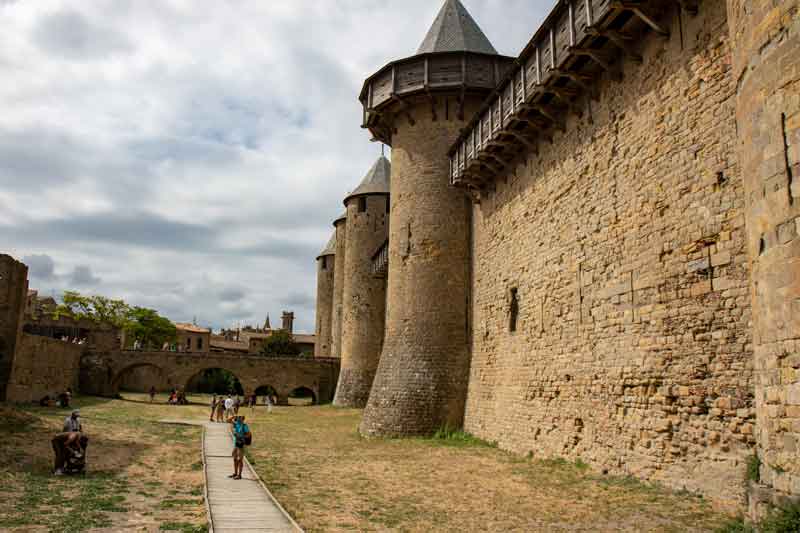
To avoid disappointment and skip the line at the Carcassonne Castle (Château Comtal), it’s advisable to book ahead so that you have guaranteed tickets to discover the Château and ramparts of Carcassone. During your visit, you will see a 12-minute film about the history of Carcassonne and its restoration, climb the square Bishop’s Tower which is the only construction to span both defensive walls and see the artworks in the Salle Pierre Embry.
Once you have finished exploring the delights of the Old City, there are plenty of restaurants with beautiful views to relax and enjoy a traditional lunch of Cassoulet with a refreshing glass of wine.
It is worth noting that Carcassonne is often very crowded during the holiday season. To avoid the crowds, it is worth arriving at Carcassonne early in the morning or later in the afternoon. We were slightly disappointed about the number of tourist souvenir shops which line the picturesque streets, but the unquestionable historical experience of Carcassonne more than outweighs this.
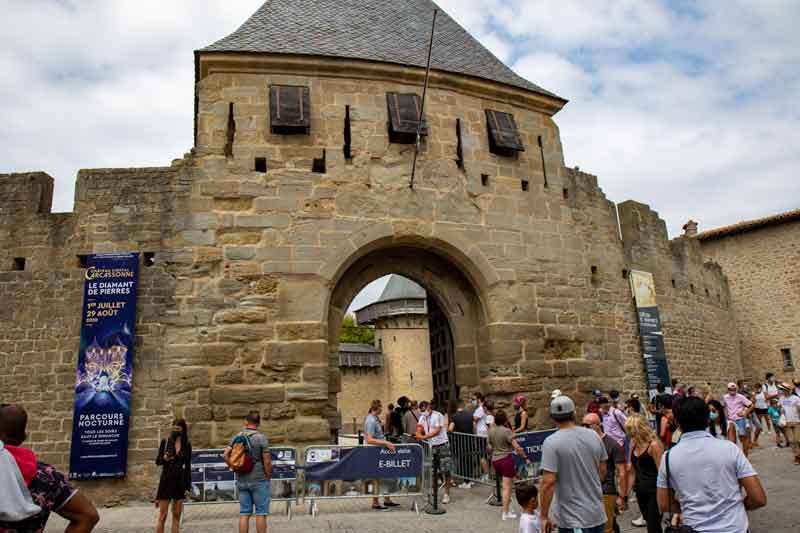
Although it is free to enter and walk around the citadel of Carcassonne, you do need to pay to visit the Château Comtal and to walk around the ramparts. However, there are still plenty of things to see and do in Carcassonne even if you don’t pay for these experiences.
What to See and Do in Carcassonne?
Carcassonne is the perfect place to lose yourself in time. As soon as you step over the drawbridge and behold the endless towering walls and turrets, you will be transported to a completely different era.
Conveniently, there is a car park close to the entrance of Carcassonne which has plenty of spaces. However, be aware that there is a charge for parking your car.
Before heading into the Old City of Carcassonne, make sure you pick up a free map from the small Tourist Office which is located near the main entrance called the Narbonne Gate (La Porte Narbonnaise).
Here are some of the things to see and do in Carcassonne:
1. Cross the Medieval Drawbridge at the Narbonne Gate (La Porte Narbonnaise), Carcassonne
The City of Carcassonne has two main gates: The Narbonne Gate (Porte Narbonnaise) on its eastern side and the Aude Gate (Porte Aude) below the Château on its western side. In fact, the interior of Carcassonne can be accessed by 4 gates which are located on each of the 4 cardinal compass points.
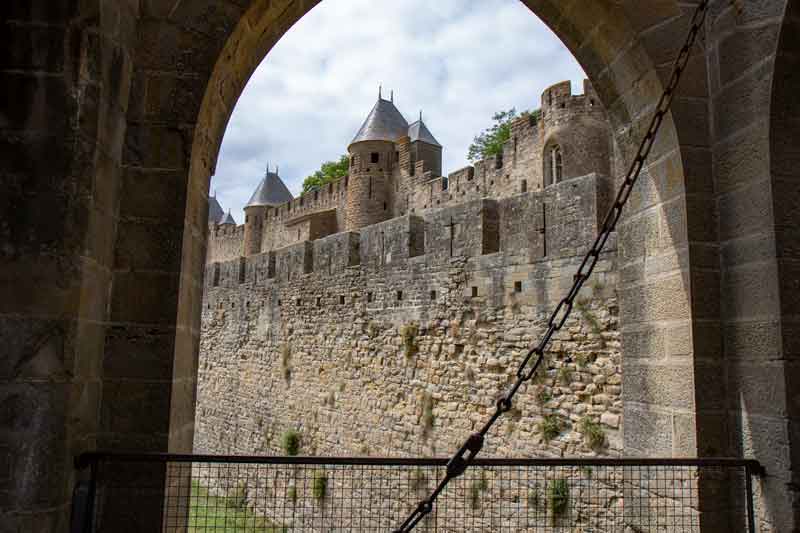
However, the main entrance to Carcassonne is via the Porte Narbonnaise. On arrival at the Porte Narbonnaise, it’s exciting to cross the drawbridge. Take time to admire the amazing view of Carcassonne’s imposing walls before you head through the striking stone towers which make you feel so small and insignificant.
2. Explore the Medieval Old City of Carcassonne
One of the great things about Carcassonne is that it is free to enter the walled Old City and explore this medieval gem at your leisure. However, it is worth knowing that access to Carcassonne’s ramparts is through the Château Comtal and there is an admission charge for entry.
If you prefer to discover the Old City of Carcassonne with the expert knowledge of a local expert, you can opt for this informative walking tour.
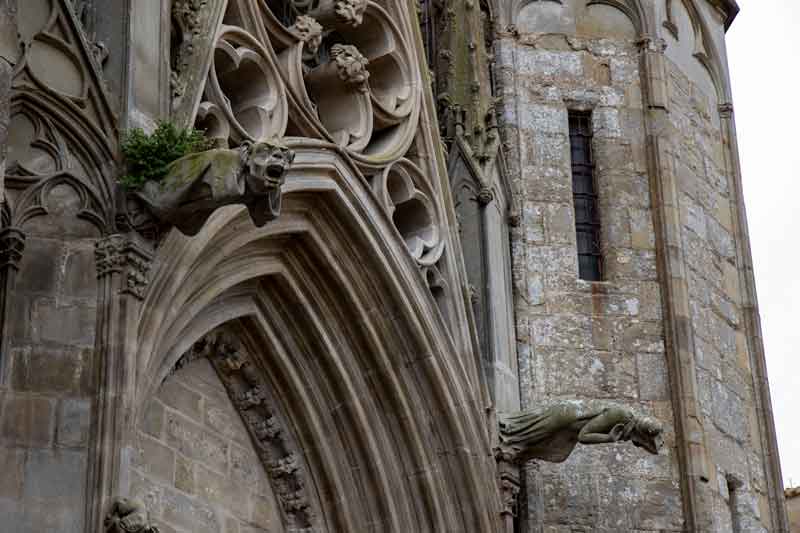
On this tour, you will discover Carcassonne’s 52 towers and visit the Basilica of Saint Nazarius and its famous stained-glass windows. In addition, you will hear incredible stories about the history of Carcassonne, learn about the defensive techniques used to guard Carcassonne and its role in the Catholic Inquisition that eliminated the Cathars. A guided walking tour certainly brings history to life!
3. Marvel at the Stained-Glass Windows in Carcassone’s Gothic Basilica of Saint Nazarius and Celsus (La Basilique Saint-Nazaire et Saint-Celse)
At the southern end of the Old City of Carcassonne is the stunning Basilica of Saint Nazarius and Celsus. This beautiful church was built in the 12th Century and is an impressive example of Romanesque and Gothic architecture. In 1898, it was upgraded to a Basilica by Pope Leo XIII.

Inside this Basilica, you can’t help but admire the beautiful stained-glass windows which are some of the oldest examples in the south of France. There are two spectacular rose windows in the north and south transepts.
4. Roam the Ramparts and Visit Carcassonne Castle (Château Comtal – Castle of Counts)
On the western side of the citadel is the Château Comtal which was built by the Trencaval family in the 12th Century. This fairy-tale looking castle is nestled against the protective ramparts of the Cité.
The admission fee to enter the castle includes:
- Privileged access to the upper part of the ramparts where you can enjoy 360-degree panoramic views of the surrounding area.
- The rampart walk and access to the hoards.
- A visit to the dungeon (donjon).
- Access to rooms in the castle and interior courtyards.
- A short film and visit to the model of Carcassonne.
- A visit to the Musée Lapidaire which is full of sculptures.
Who can resist a walk around the ramparts of a castle and being transported back to a time of medieval Knights, bows and arrows and defensive battles?
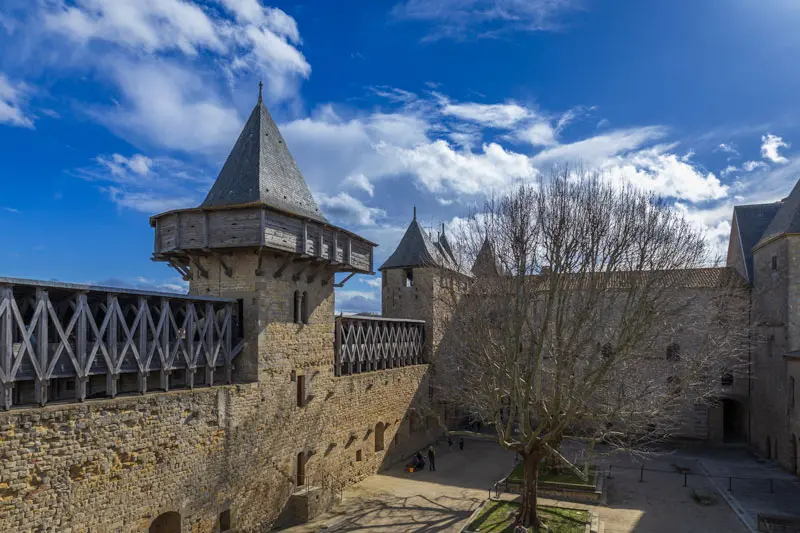
To avoid disappointment, don’t forget to book your ticket to the castle in advance! Queues build up quickly in the summer months so you can skip the line by using this link
5. Go Back to School and Visit the School Museum (Musée de L’École) in Carcassonne
Perhaps surprisingly, there is a School Museum hidden in the heart of the medieval citadel of Carcassonne. If you are interested in seeing what schools were like in France at the time of the 3rd and 4th Republic, you can explore the 5 rooms which are full of teaching tools and resources from 1880 to the 1960s. There is a small charge for entry.
6. Eat Local Specialities in Carcassonne
Whilst you are in Carcassonne, don’t miss out on trying some of the regional dishes. Carcassonne is renowned for its Cassoulet. This is a filling casserole dish made from white haricot beans, sausage and duck or goose confit. A good one is delicious and very satisfying!

There are plenty of small restaurants within the Cité walls which serve delicious food and wine with stunning vistas of Carcassonne.
Where is Carcassonne France?
Carcassonne is situated in the south of France which forms part of the continent of Europe. This stunning medieval walled town is located in the Department of Aude in the Region of Occitanie which was once known as Languedoc-Rousillon. Carcassonne is perched on a hillside location on the right bank of the River Aude between the Pyrenees and the Massif Central.
This UNESCO World Heritage Site is approximately 80km south-east of Toulouse (approximately 1 hour by car) and 60km west of Narbonne (approximately 45 minutes by car). Carcassonne is also not far from the border with Spain.
Map Here
History of Carcassonne France
Carcassonne dates back over 2,500 years. The site was occupied as early as the 5th Century BCE by the Iberians then Gallo-Romans. The inner rampart was built in 485 CE under the rule of Euric I, King of the Visigoths.
Later, between 1096 and 1150, the Viscounts of Carcassonne and Béziers built the Basilique Saint-Nazaire. In 1125, the Château Comtal was built into the Visigothic ramparts.
In 1209, the Crusade against the Cathars began. Carcassonne was conquered and Simon de Montfort became the new Viscount of Carcassonne. After 1233, Carcassonne became an important religious tribunal during the Inquisition when the Catholic Church continued its quest to combat heresy.
Eventually, Carcassonne fell into disrepair and its ruins were due to be demolished by the French Government. However, in 1844, the architect Viollet-le-Duc was commissioned to restore the medieval walled town to its former 13th Century magnificence complete with its iconic grey slate pointed towers.
Visit Other Places of Interest in the Carcassonne Area
Why not combine your visit to Carcassonne with visits to other places of interest in the surrounding area?
Le Canal du Midi, Carcassonne
This famous French canal links Toulouse and Sète and was originally used to transport goods and people. The Canal du Midi winds itself through the vineyards to the centre of the town of Carcassonne. You can take a bike ride along the old towpaths, enjoy a walk or hire a boat and enjoy the scenery.

Lac de la Cavayère, Carcassonne
Near the medieval city of Carcassonne is a beach! Just 10 minutes (6km) by car from Carcassonne, you will find the leisure complex of Lac de la Cavayère. The Cavayère Lake was formed by a dam in 1988 and has 3 sandy and pebble beaches. Swimming is permitted in the summer months from 1pm to 7pm (complete with lifeguard).
The lake is surrounded by pine woodland and is a great spot for rambling or cycling and having a relaxing picnic. In addition to the 5km circuit around the lake, there are many other activities to enjoy here. These include inflatable water games, pedalos, water ski lift, wake board, paddle, mini golf, volleyball and there is even a treetop walk through the forest with zip wires over the lake!

